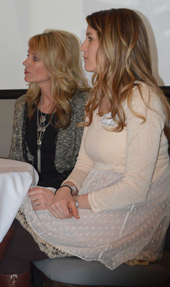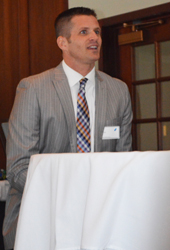At Sunfield Elementary in Lakewood Public Schools, students read while waiting in line for the bathroom. At North Godwin Elementary in Godwin Heights, kindergartners practice memorizing more words by sight than at most other schools. At Byron Center’s Brown Elementary, Principal Barb Johnson is likely to know the reading level of any student passing by.
These are details a group of curriculum leaders learned by visiting five schools that are overachievers on third-grade reading MEAP tests. The visits, done over eight months, were part of the Reading Now Network field study. The study sought to discover the instructional practices among these schools that led to the high scores, in a collaborative effort to lift third-grade reading proficiency for all of West Michigan.

“When we pull this off we are going to make a change in our profession and the lives of a half-million children,” said Pete Haines, Greenville Public Schools Superintendent and a member of the Reading Now Network steering committee.
Reading Now Network is an effort involving 13 counties and 100 school districts in West Michigan that signed on to learn about, and then implement, these winning practices. Schools studied ranged from urban to rural, with varying levels of poverty, and each significantly outperformed their peers. They are: Brown, North Godwin, Lakeshore, Coit Creative Arts Academy in Grand Rapids Public Schools, and Sunfield Elementary in Lakeview Community Schools.
“We have to come together in a spirit of cooperation and learning around professional standards for how we help students achieve,” said Ottawa ISD Superintendent Karen McPhee. “Whether we like it or not, we live in a competitive environment…but there are some things we just cannot, from a moral imperative, compete about anymore. One of them is early literacy and the success and confidence we know our children must have around their ability to read.”

Achievement is Result of Collaboration, Culture
The study group’s findings were recently unveiled at a symposium attended by more than 300 educators who have committed to work together to improve students’ success. Videos with footage from school visits, including interviews with teachers, administrators and students, tell the story of how things work in each school.
Field study members said a few things became clear: The schools weren’t all using the same curriculum. There was no magic formula or teacher-training practice. But common threads existed at each of the schools that were having the same positive, collective impact on students and teachers.
Other similarities: Expectations of high achievement were embedded into every part of the school day. Teachers believed in their students, and students believed in themselves. There were no missed opportunities to grab a book. The school day included a guaranteed time–as much as 120 minutes for kindergarten through second-graders and 90 minutes forthird- through fifth-graders to receive whole-group, small-group and one-on-one instruction.
|
Common Traits Among Schools with High Reading Proficiency
|
“We found a powerful focus on reading in all these schools, and that focus pervaded their entire culture. It was just what they did. It wasn’t just their school improvement goals or mission and vision; it came out in every single student,” said field study member Erin Brown, K-12 English Language Arts Consultant for the Muskegon Area Intermediate School District.
Field study member Nicole Gasper, supervisor of Learning Services for Newaygo County Regional Educational Service Agency, said everyone at the schools had a “growth-mindset,” knowing there is still work to be done.
“This has been the very best professional learning experience of my educational career,” Gasper said. “The opportunity allowed me to see the best research in implementation. I got to see things I’ve read and learned about happening with children on a daily basis in real classrooms,” she said.
Instruction was built around data concerning every child, and teachers worked together to ensure all students at all levels were continuously improving. Students knew their test scores and used them for setting goals. Teachers used data from several assessments in instruction.
Putting Practices in Place
Educators said they were eager to share findings.
“I’m hoping to take what we have learned today about the five findings and go back into my school building and share with staff and get them excited and fired up and highly engaged in these activities,” said Jennifer Slanger, Principal at Wyoming Public Schools Oriole Park Elementary School. “I really feel these are best practices that I’ve read about and seen in action in some of our classrooms. But when you see them in pockets you’re not going to have that global effect. They need to be happening in every classroom, every day, and the common expectations are key.”

Sara Dewey, reading specialist at Godfrey Lee Public Schools, said the findings show how much collective ownership is needed.
“What has resonated the most with me is the goal-setting with the students,” she said. “The students know their goal; they take ownership of their goal and they are excited about it. But it’s not just the student. The staff and principal know each student’s goal. That really, really means a lot when everyone is taking ownership, that ‘This is were we need to go next. This is what we need to do to get to the next level.'”
CONNECT









